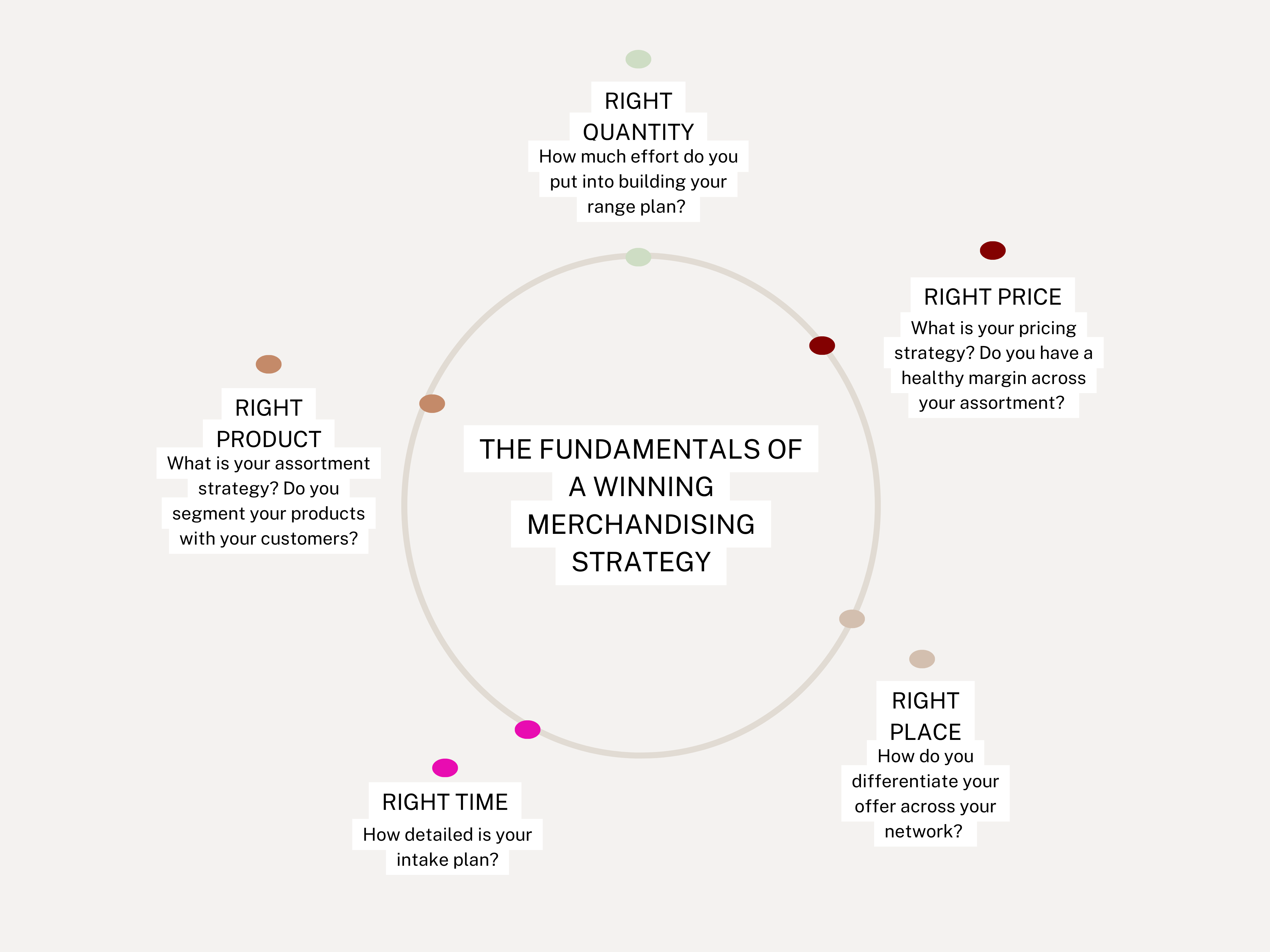The Best Merchandising Strategies to Sell Your Products
BUSINESS STRATEGY / 17 SEPTEMBER 2024

What is merchandising?
Merchandising plays a crucial role in executing a successful business strategy. It includes all activities related to purchasing, selling and promoting products to customers. Whether in a physical store or digital platforms, effective merchandising is pivotal in shaping a retailer’s or brand’s commercial success.
The fundamentals of well-executed merchandising can be defined under five key principles.
The right product, at the right price, with the right quantity, at the right place, and at the right time.
The fundamentals may seem quite straightforward, but implementing them effectively and meaningfully often requires a sizeable team within an organisation. In larger organisations, the merchandising function is known as the core of the business. This is because the product assortment sets the tone of the brand, which then has a knock on effect throughout the organisation, one stakeholder at a time.
Why Merchandising Matters
Merchandising is not a new concept in the retail world. It is (or at least aims to be) 100% customer-centric. This means that every activity should revolve around the customers needs and wants. Merchandise strategies are implemented to maximise profitability through detailed product assortment plans that aims to enhances customer engagement, boosts product visibility and achieves sales targets. The more engaged customers a business can reach, the more likely it is to thrive in the marketplace and fulfil its greater organisational mission.
Elements of a Merchandising Strategy
Retail merchandising involves customised strategies best suited to the business model and their desired goals. However, regardless of their vision, all retailers should incorporate each of the four major elements into their merchandising strategy to boost productivity and growth.
These elements include: assortment, pricing, product and space.
1. ASSORTMENT
Formulating the right mix of products that are commercially viable and aligned with their target customers should be a priority for every retailer. The level of detail within an assortment strategy can be determined based on the size, phase or capabilities of the business. Retailers need to find a planning model that suits their business goals. At a minimum, retailers should prioritise creating a merchandise and assortment plan that leverages qualitative and quantitative data.
- OTB Plan: Open-to-buy (OTB) is a financial budgeting tool. It is used in retail to calculate the amount of money available for purchasing new inventory. It helps retailers plan inventory levels, control stock, and ensure there is adequate merchandise to meet customer demand without overbuying.
- Merchandise Plan: This planning tool sets the budget for all product categories across the business
- Assortment Plan: A supporting planning tool that helps determine the right mix of products, categories, sizes, colours for every location
KPI’s to measure success: Intake budget, sales forecast/budget, sell thru, COGS, GRMOI.
2. PRICE
When launching a new brand or product, most entrepreneurs focus their creative energy on developing the idea and turning it into a sellable product. However, before any product is viable for sales, it is crucial to determine its worth. This is where a well considered pricing strategy comes into play. The initial price should always be the best price. This prevents retailers from giving away profits during discount wars. Setting competitive prices that balance profitability with customer demand may involve planning promotions that align with key events to drive sales.
- Pricing Strategy: Using a consistent framework like the ABC method or Good-Better-Best models to define a pricing strategy.
- Promotional Calendar: Plan and build in promotions to profit margins for tactical events.
KPI’s to measure success: Average selling price, markdown %, discount rate, gross profit margin.
3. PRODUCT
Optimising merchandising strategies is essential for retailers to maximise their products. This involves developing a robust inventory plan at the start of each season or product life cycle, closely monitoring stock levels, replenishing in-demand items, and efficiently managing slow-moving products. These efforts ensure that the right products are readily accessible to meet customer demand.
- Quantification Strategy: Tier products in order to execute a quantification strategy to push best sellers and de-risk slow movers.
- WSSI: Referred to as the “Weekly Sales, Stock and Intake”. This planning tool shows the past, present and future sales performance by week. It can support businesses make well informed trading decisions.
KPI’s to measure success: sell thru, rate of sale, weeks cover, closing stock, gross profit margin, return rate, stockout rate.
4. SPACE
Space can often be overlooked by retailers. It is more than just arranging products in a way that enhances the customer shopping experience. When planning merchandising strategies, the space in which they choose to display, sell or promote their products whether physical or virtual is a critical component to be considered. It requires a more collaborative approach with other functions within the business such as sales, visual merchandising, e-commerce, operations and real estate. Customer engagement is all about the emotional connection that your brand creates. Whilst there are various components as to how to achieve this, designing product displays and store layouts plays a big role particularly when it comes to attracting customers and encourage purchases. Consistency and personalisation t builds trust and loyalty.
- Space Planning: Plan and monitor store layouts to support assortment strategies.
- Visual Merchandising Guidelines: Bring the assortment strategy to life with a well detailed VM plan.
KPI’s to measure success: Traffic, conversion rate, sales per sqm, cross selling rate, average sales per customer.
Merchandising is a multifaceted process that goes beyond simply arranging selecting products to display on shop front shelves. It integrates product selection, pricing, visual presentation, and inventory management to create a compelling customer experience. Whether your goal is to increase sales, enhance brand loyalty, or optimise stock levels, adopting an effective merchandising strategy can lead to significant business success.
Need more support in putting together a considered merchandise strategy for your products? Contact us to discuss your current challenges.







Read the Comments +